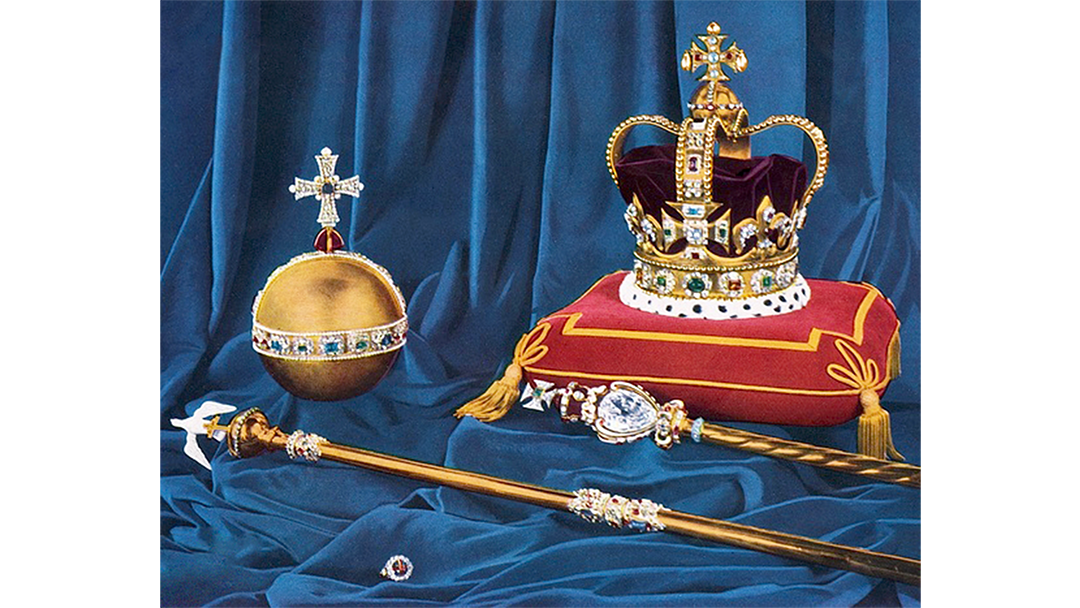We’re just a few days away from King Charles III official coronation, so we want to give you a quick primer on some of the jewelry and precious objects, known as Coronation Regalia, that you will be seeing. The Coronation Regalia is imbued with symbolism and meaning because at its core a Coronation is a religious ceremony. According to BBC, the coronation commemorates “the monarch’s role as the head of the Church of England and marks the transfer of their title and powers.” As such, the coronation jewelry has religious, cultural and historic meaning.
The St. Edward’s Crown
The most notable item and the centerpiece of King Charles III coronation will be the St. Edward’s Crown. It was made in 1661 for King Charles II, who reigned from 1660 to 1685. It was a replacement for another crown that had been melted down in 1649 by Oliver Cromwell after the execution of Charles I. According to Buckingham Palace, the crown that was melted down dated back to the 11th century and Edward the Confessor, the last Anglo-Saxon King of England and a royal saint. The St. Edward’s Crown, which weighs almost five pounds, has a velvet hat and an ermine fur band attached to a solid gold frame that is decorated with ruby, amethyst, sapphire, garnet, topaz and tourmaline. Rising from the frame are four crosses-pattee (crosses that are narrower in the center with flared arms) and four fleur-de-lis. Two arches criss-cross at the top of the crown, which is adorned with an orb and cross symbolic of the Christian world. The last time the crown was worn, was in 1953 when Queen Elizabeth II was Coronated. A quick note about crowns and how they differ from tiaras: crowns go full circle around the head, they’re tall and may only be worn by royalty – a king, queen, prince or princess, they are also generally ceremonial in nature as they can be quite heavy. Tiara’s go about three-quarters of the way around the head and can be worn by anyone.
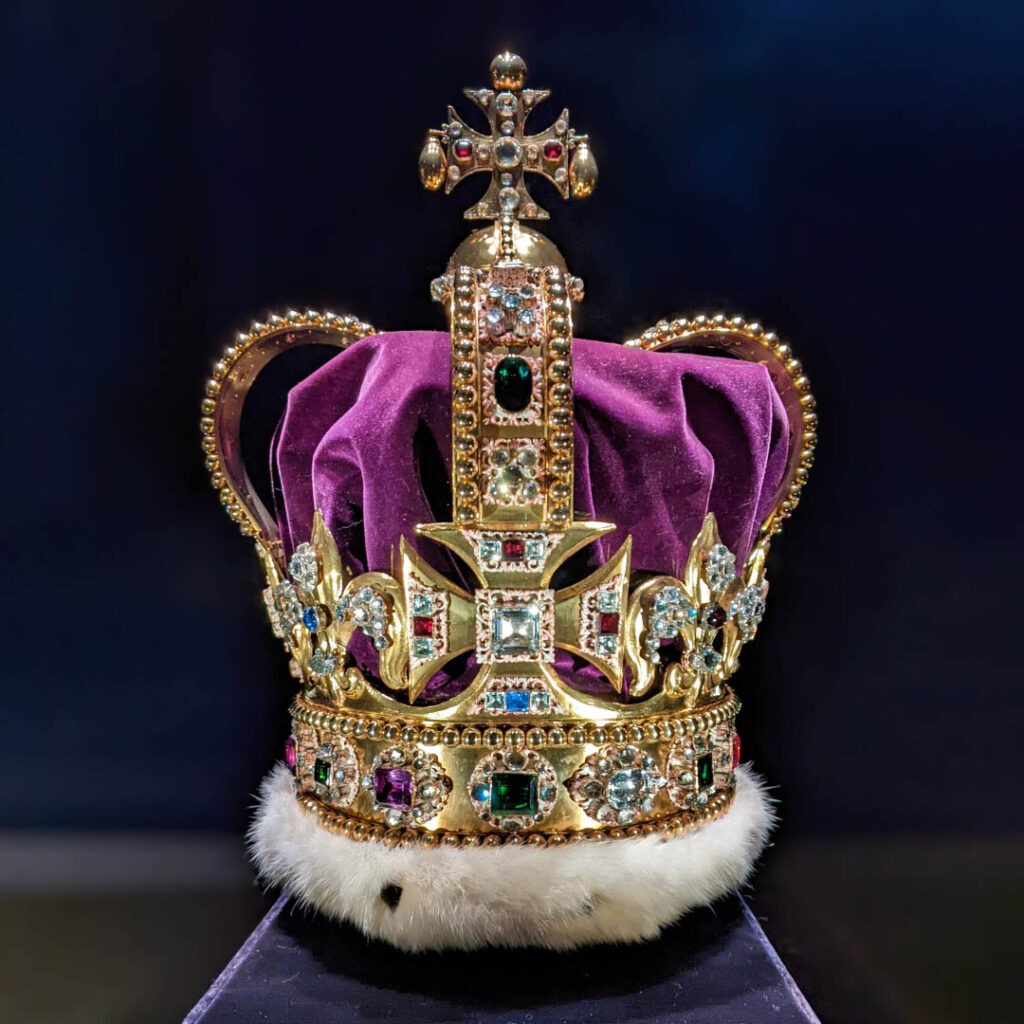
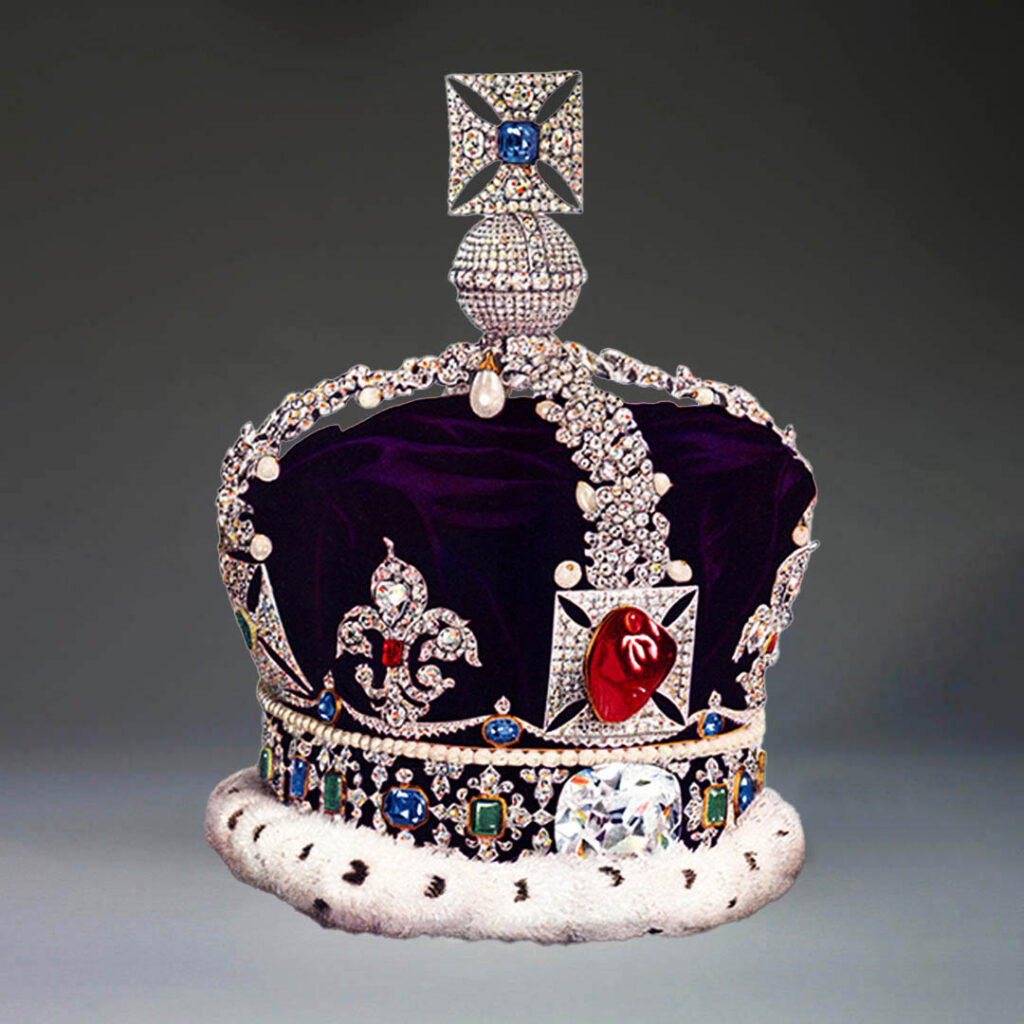
The Imperial State Crown
The Imperial State Crown is worn as the Monarch leaves Westminster Abbey where the Coronation takes place. According to the Royal Collection Trust website, the Imperial State Crown was made for the Coronation of King George VI in 1937. It replaced a crown that was made for Queen Victoria and at 2.3 pounds, it’s lighter than St. Edward’s Crown. The crown glitters with 2,868 diamonds, 273 pearls, 17 sapphires, 11 emeralds and five rubies. The crown features the St. Edward’s Sapphire, which is said to have been worn as a ring by Edward the Confessor. Another very famous gem in this crown is the Prince’s Ruby, which is actually a spinel. It also showcases the Cullinan II diamond, the second largest diamond cut from the rough Cullinan diamond. Besides the Coronation, the Imperial State Crown is worn by the monarch at the opening of Parliament and other state occasions.
Queen Mary’s Crown
Let’s not forget Queen Camilla, who will don Queen Mary’s crown for the coronation. According to the Royal Trust Collection, this crown sparkles with 2,200 diamonds. It was first designed for Queen Mary’s Coronation in 1911. Originally, the crown showcased the Koh-I-Noor, Cullinan III and Cullinan IV diamonds. They were replaced with crystal replicas sometime after the Coronation. For the upcoming Coronation the crown has been reset with the Cullinan Diamonds III, IV and V. The crown will also have some other modifications to the arches around the top, so what you see pictured here, will look different when it is seen on May 6.


The Sovereign’s Scepter with Cross
The Sovereign’s Scepter represents good governance and temporal power and has been used in every Coronation since it was first made for Charles II in 1661. The Sovereign’s Scepter is a gold rod with an enameled heart shaped frame that showcases the Cullinan I diamond. The 530-carat Cullinan I Diamond was added to the scepter in 1911 by Crown Jeweler Garrard. The diamond is so heavy that the scepter had to be reinforced to handle its weight.
The Sovereign’s Orb
The Sovereigns Orb was made, by royal jeweler Robert Viner (sometimes spelled Vyner), for King Charles II’s coronation. It is a hollow gold sphere decorated with 365 diamonds, 375 pearls, 18 rubies, nine emeralds, nine sapphires, one amethyst and one glass stone. The pearls frame the gems that go around the circumference of the Orb, which is considered a symbol of “Godly power”. The Orb has a cross on the top representing “Christ’s dominion over the world”, as the Monarch is considered to be God’s representative on earth.
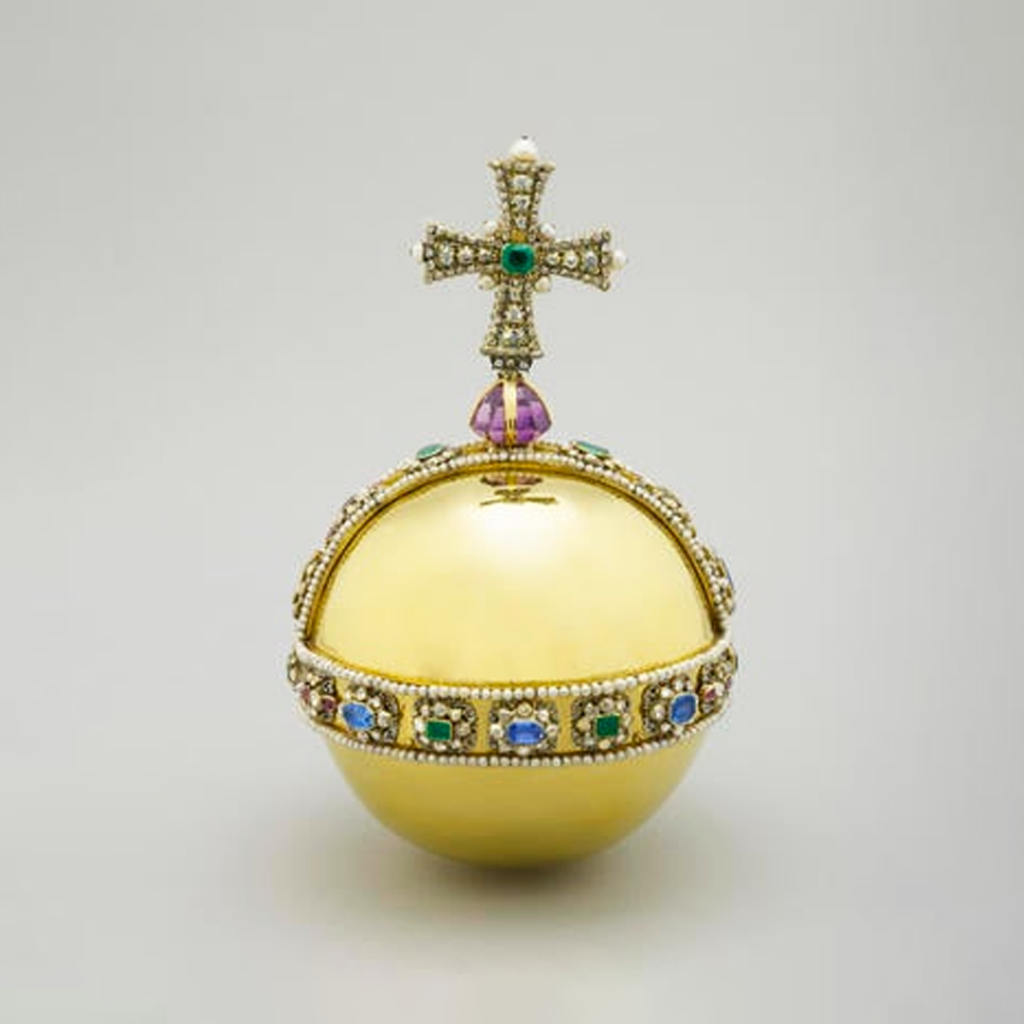

The Sovereign Ring
On a more personal note, the King is presented with the Sovereign Ring. The Sovereign Ring has been used in Coronations since it was first made for King William IV for his crowning in 1831. The ring highlights a blue sapphire overlaid with rubies in the shape of a cross and a surround of cushion shaped diamonds. The design is reminiscent of the British flag. During the Coronation, the Archbishop of Canterbury places the ring on the fourth finger of the Sovereign as a symbol of “Kingly dignity”.
Queen Consorts Ring
The Queen Consort also gets a ring that is used for the Coronation, known as the Consorts Ring. The ring was originally made by King William IV in 1831 for his wife Queen Adelaide. It features an elongated mixed-cut ruby center stone with a frame of cushion cut diamonds set in a gold mounting with rubies all around the shank. When William passed away he left his Sovereign ring to Queen Adelaide. She then left William’s Sovereign ring and her Consort ring to Queen Victoria, who keeping the same design, had a new Sovereign ring made that fit her hand, which was much smaller than William’s. Queen Victoria left the three rings to the crown in 1901. A number of years later, King George V sent the three rings to the Tower of London where they reside today. Since the Coronation of King William IV, Queens Alexandra, Mary and Elizabeth, the Queen Mother have all worn the ring to the Coronation. The ring was made by royal goldsmith Rundell, Bridge & Rundell. Until the 20th Century these rings were kept in the personal possession of the monarchs, but they are now part of the Crown Jewels.
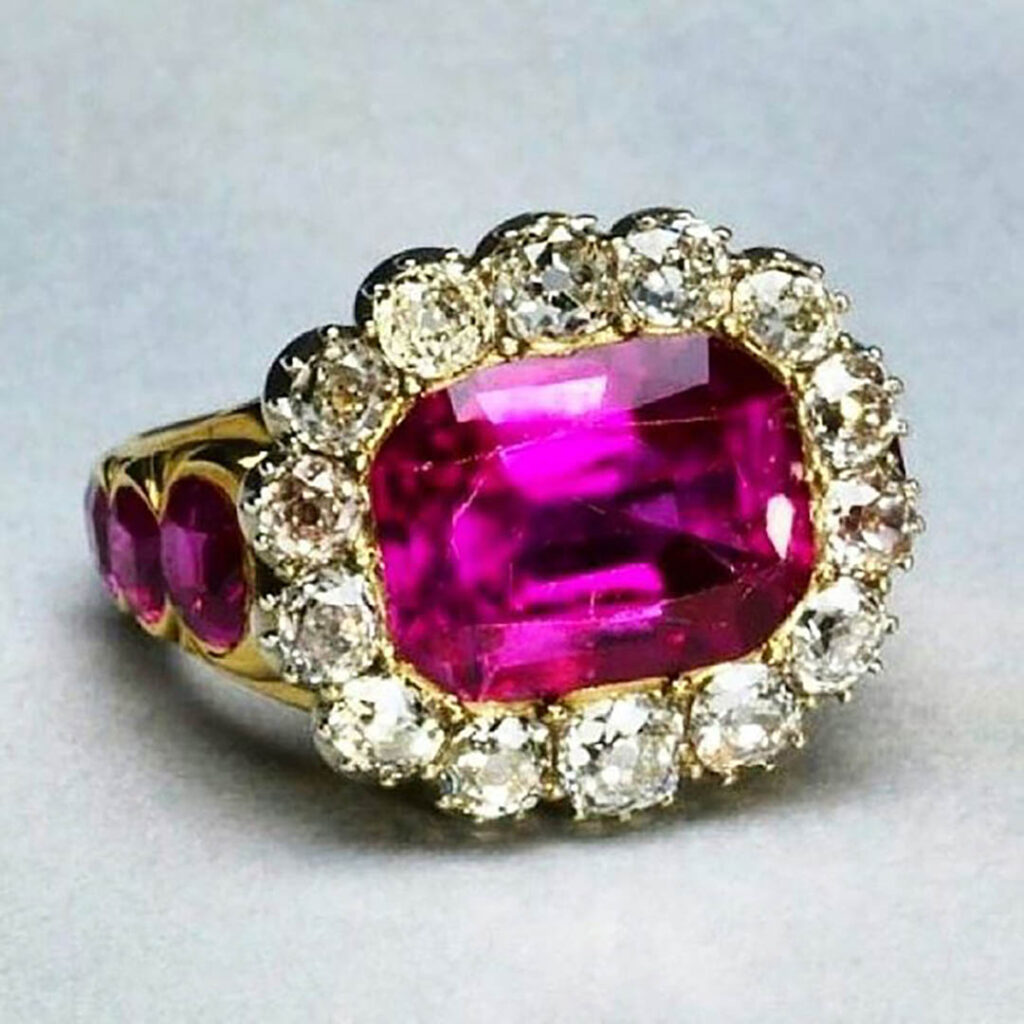
As we watch the Coronation, we can look at these fabulous jewels not only for their beauty and symbolism, but for the important place they hold in past history, in the making of history and in future history.
Featured image (top of page): Crown Jewels of the United Kingdom, St. Edward’s Crown, Sovereign’s Orb, Scepters and Ring. Taken in 1952, this is the first color image of the crown jewels that was ever published, appearing in Illustrated magazine on December 13, 1952.
Authored by Amber Michelle
